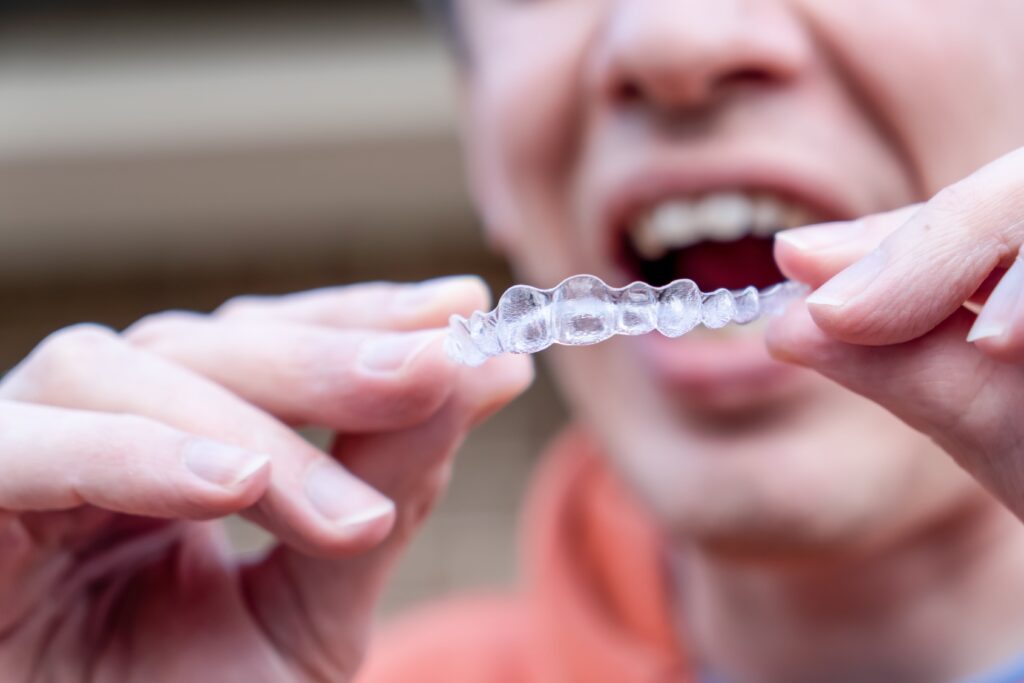Switching to a plant-based or vegetarian diet can offer numerous health benefits—improved heart health, lower…
Straighten Your Smile: The Benefits of Invisalign vs. Braces

When it comes to straightening your smile, two of the most popular options are braces and Invisalign. Both of these methods have their own unique benefits and drawbacks, and it’s important to weigh them carefully before making a decision. Knowing the pros and cons of Invisalign vs. braces can help you make an informed choice about which treatment is right for you. Whether you’re dealing with crooked teeth, gaps, or other orthodontic issues, there are plenty of factors to consider before beginning your journey towards a healthier, happier smile.
What is Invisalign?
Invisalign is a modern alternative to traditional metal braces for straightening teeth. It uses clear aligners made of smooth, BPA-free plastic that are custom-fit to your teeth to gradually shift them into the correct position.
Metal or “traditional” braces
Many people wonder which treatment is best for them. While traditional metal braces have been around for decades and are proven to be effective, they come with their drawbacks. Metal braces are often seen as unattractive, uncomfortable, and difficult to clean. Additionally, treatment time for traditional braces can take years.
Aligners
On the other hand, Invisalign has become a popular choice for those who want to straighten their teeth without drawing attention to their dental work. The aligners are virtually invisible, comfortable to wear, and easy to clean. Invisalign cost can be higher than traditional braces, but the benefits may outweigh the added expense.
For those looking for fast braces, Invisalign can be a good option as treatment time is usually shorter than traditional braces. With proper care and maintenance, Invisalign aligners can be an effective and discreet way to straighten your smile.
What are the benefits of using Invisalign vs. braces?
When it comes to straightening teeth, many people assume that braces are the only option. However, with advancements in orthodontic technology, there is now a range of alternatives available, including Invisalign and other clear aligners. Here are some of the key benefits of choosing Invisalign over traditional metal braces:
Aesthetic appeal
Invisalign aligners are clear and nearly invisible, which means that they are a great option for adults or teenagers who are concerned about the appearance of metal braces. This is especially true if you have a job that requires you to be in front of people frequently, or if you simply don’t want to feel self-conscious about your smile.
Comfort
One of the most significant benefits of Invisalign over traditional braces is that the aligners are made of a smooth, flexible plastic that doesn’t irritate the gums or cheeks. This means that you can avoid the discomfort that is often associated with metal braces, such as mouth sores or sharp wires poking at the mouth.
Fewer restrictions
Metal braces require some dietary restrictions, such as avoiding sticky or hard foods that could damage the brackets and wires. With Invisalign, there are no such restrictions because you can remove the aligners before eating. This also means that you can continue to enjoy your favorite foods without worrying about damaging your braces.
Easy to clean
Keeping traditional metal braces clean can be a challenge, as food particles can get stuck in the wires and brackets. Invisalign aligners are removable, which makes cleaning them a breeze. Simply remove the aligners, rinse them with water, and brush them with a toothbrush.
Comparable costs
Invisalign cost may be comparable to that of traditional braces, depending on your specific treatment needs. While Invisalign can be slightly more expensive upfront, there are some factors that can make Invisalign vs. braces more affordable in the long run. For example, Invisalign treatment may require fewer office visits and adjustments than traditional braces, which can result in less time missed from work or school.
Overall, there are many benefits to using Invisalign over traditional metal braces. However, it’s important to remember that everyone’s teeth and treatment needs are unique. Talk to your orthodontist to determine which treatment option is best for you.
Factors to consider when choosing between Invisalign and braces
When deciding between Invisalign vs. braces, there are several factors to consider.
Duration of treatment
One major consideration is the length of treatment time. Invisalign typically requires a shorter treatment time than metal braces, although there are fast braces options that may be comparable to Invisalign.
Visibility
Another factor to consider is the level of visibility. Invisalign aligners are clear and nearly invisible, while metal braces are noticeable. However, some people prefer the look of metal braces and find them to be more traditional.
Cost
Cost is also an important factor to consider. In general, Invisalign is more expensive than metal braces. However, the cost of treatment may vary depending on the individual case and the length of treatment needed.
Maintenance
Maintenance is also different for each option. Invisalign aligners are removable, so they require less maintenance than metal braces, which need to be adjusted and tightened regularly by an orthodontist.
Specific issues
Lastly, some people may have certain dental issues that can only be treated with metal braces vs. Invisalign. It’s important to discuss all of your options with an orthodontist to determine the best course of treatment for your specific needs.
In summary, there are many factors to consider when choosing between Invisalign and braces. These factors include treatment time, visibility, cost, maintenance, and specific dental issues. It’s important to weigh all of these factors to determine which option is best for you.
Which treatment option is best for you?
Choosing between Invisalign and braces can be a difficult decision, as both treatment options have their own unique benefits and drawbacks. Here are some factors to consider when deciding which option is best for you:
Appearance
If you’re self-conscious about the appearance of traditional metal braces, Invisalign may be a better option. The clear aligners are virtually invisible and won’t draw attention to your mouth like traditional braces can.
Lifestyle
Invisalign is removable, making it easier to eat, brush, and floss. If you’re an athlete or musician, it may also be a better option, as it doesn’t interfere with activities like playing instruments or contact sports. However, if you’re forgetful or have trouble sticking to a routine, braces may be a better choice since they can’t be removed.
Complexity of Treatment
Invisalign is best for treating mild to moderate cases of misaligned teeth. If your orthodontic needs are more complex, traditional braces may be the better choice. Metal braces offer greater control over tooth movement, allowing for more precise adjustments and a better end result.
Cost
In general, Invisalign tends to be more expensive than traditional braces. However, the exact cost will depend on your specific treatment needs and insurance coverage. It’s important to speak with your orthodontist to determine which option is the most cost-effective for you.
When considering the options of metal or ceramic braces vs Invisalign, it ultimately comes down to personal preference and individual needs. Consult with your orthodontist to discuss which option is the best fit for your unique smile.
Frequently asked questions
What is the main difference between Invisalign vs braces?
Invisalign uses clear aligners that are almost invisible and removable, while braces use metal brackets and wires that are attached to your teeth.
Is Invisalign more expensive than metal braces?
The cost of Invisalign vs. braces can vary depending on your specific case and the length of your treatment. In general, Invisalign can be more expensive, but it also has benefits such as being more discreet and easier to maintain.
Are metal braces more effective than Invisalign?
Both metal braces and Invisalign can be effective in straightening teeth. However, metal braces may be more effective in treating complex cases or severe bite problems.
How often do I need to see my orthodontist with Invisalign vs. braces?
Typically, patients with metal braces need to visit their orthodontist every 4-6 weeks, while patients with Invisalign need to have their aligners changed every 1-2 weeks and have a check-up every 6-8 weeks.
Can I eat and drink normally with Invisalign vs. braces?
With metal braces, there are certain foods that you need to avoid or cut into small pieces to prevent damage to the brackets and wires. With Invisalign, you can remove your aligners to eat and drink normally, as long as you brush your teeth before putting them back in.
How long does treatment last with metal braces vs. Invisalign?
The length of treatment can vary depending on your specific case, but metal braces typically take 1-3 years, while Invisalign can take 6-18 months.
Is Invisalign more comfortable than metal braces?
In general, Invisalign can be more comfortable because the aligners are made of a smooth plastic material that doesn’t irritate the gums or cheeks. However, metal braces can also be comfortable with the use of wax to prevent irritation.
Can Invisalign be used for children and teenagers?
Invisalign can be used for children and teenagers who have all their adult teeth and are able to comply with wearing the aligners as instructed. However, metal braces may be a better option for younger patients with developing teeth.


